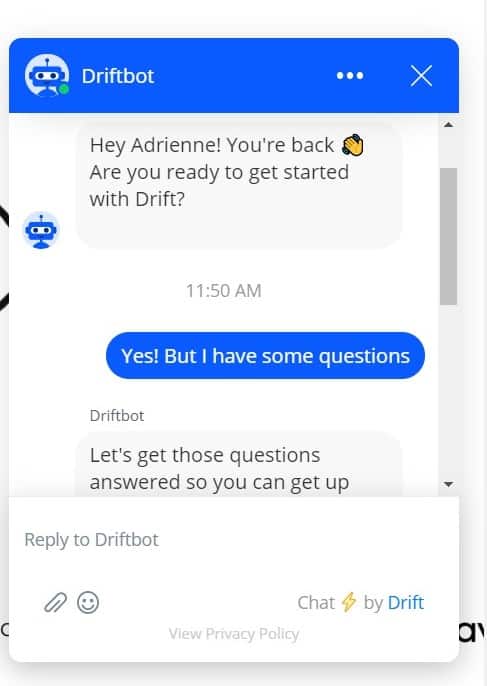
Curious as to how you can increase your MRR by 25% in one week? Or maybe you want to 10x your trial conversions? Or see a 5x increase in acquisitions?
Statements like that are usually followed by a bunch of fluff and nonsense, but not here! The feedback loop is a powerful process that can propel your business into growth mode, and we’ve got all the juicy details to share with you.
The B2B economy demands personalization and great customer experience, and the best way to meet the needs of your customers is to create a feedback loop.
In this piece, I’ll show you real world examples of how successful feedback loops helped increase sales, how you can implement a feedback loop culture in your company, and what tools are the best for creating a feedback loop.
What Is A Feedback Loop?
A feedback loop is a constant process where you listen and talk to your customers, then make changes based on repetitive evaluations. It means starting from a place of humility, knowing there is always room for improvement.
If you have a successful feedback loop, it means you’ve created a culture where learning, growing, changing, and curiosity are a central part of your growth strategy, and no one relies on assumptions or hunches when making decisions.
Claire Lew shared a framework with Sprout Social that helped to eliminate assumptions and create a feedback loop culture.
She says it comes down to two simple things:
- You have to ask for feedback.
- You have to act on it.
When you’ve created a feedback loop culture, it impacts the entire company, not just the product or marketing – it becomes the way you operate your business.
6 Steps To A Successful Customer Feedback Loop Strategy
Creating a customer feedback loop is a great way to take a step back and view your company, product, or process from the customer’s point of view. Feedback allows you to understand everything from a higher level, because so often, when people work closely with a product or project, they have a tendency to become too close and lose sight of the larger picture.
It’s like the saying, “You can’t see the forest through the trees.” Customer feedback allows you to see the entire forest, streams, and the meadows.
Here are six steps you can take to have a successful customer feedback loop:
1. Give your customers multiple ways to get in touch with you
If the only way customers can speak to you, or interact with you and your organization is through a customer service phone number or email, you aren’t creating an inclusive opportunity for your customers to reach you. You want them to feel comfortable in all of their communication with you. Giving them multiple avenues allows your customers to choose the one they are most comfortable with.
2. Respond quickly to customers
If your customers can reach you through multiple formats, but don’t hear back for days or weeks, then you aren’t going to create a feedback loop culture that helps you increase sales. When you can speak to your customers in real time, it sends a clear message that their needs are important.
3. Ask customers about their experience
The best thing you can do to get to know your customers better is to ask them. You can have a conversation with your customers in real time using conversational marketing tools, webinars, and 1:1 calls.
4. Collect customer responses
When you receive feedback, it’s important to have a system in place that allows you to store the responses in an organized manner. If you can’t refer back to specific feedback you received from multiple customers, it’ll be challenging to make the right kind of changes.
5. Take the time to review customer responses as an organization
Make time to review feedback as either an organization, department, or team. How long and how often these review meetings are held depends on your company. At Demio, we emio meet once a week to discuss customer feedback, while other companies wait to review every quarter or twice a year.
6. Change what makes sense
Creating a successful customer feedback loop doesn’t mean you always do everything every customer wants you to do. It’s taking a look at a large pool of feedback and making the changes that will help the company achieve its goals. Once you’ve reviewed the feedback as an organization, determine which adjustments should be implemented, which can be considered in the future, and which ones don’t align with business goals and should be tossed away.
The 4 Best Tools To Create A Customer Feedback Loop
Since creating a customer feedback loop culture centers on using conversations with your customers – it should come as no surprise that the tools that will help you foster a customer feedback loop allow you to speak with your customers effortlessly, conveniently, and consistently.
1. Conversational Marketing: Implementing a chat tool or chatbot on your site can help your customers get answers quickly, and allows you to ask specific questions about their experience. Drift offers chat automation and live chat so your customers can get in touch 24/7.

2. Webinars: Webinars are a great way to gather feedback from your customers. The audience is there with you, learning from you, and you’ve established a form of trust throughout your interactions, so it’s a great way to ask for specific feedback.
3. Phone: Yes, it may be “old school,” but for some customers or companies, the phone is still the best way to reach your customers and ask for feedback.
4. Email: Another “oldie but goodie,” email is still a tried and true way to communicate for many people. You’re able to add surveys or questionnaires, and your customers can respond when it’s convenient for them.
The key to communicating with your customers is to meet them where they are most comfortable.
Drift made this point clear in their 2019 State of Conversational Marketing:
“Ultimately, your goal should be to communicate the way your leads and customers prefer to communicate. Remember: Conversational marketing isn’t about forcing people to use specific channels, it’s about having conversations and providing the best experience possible.”
That statement stands true for customer feedback loop information as well. You’ll get better feedback if you reach your customers where they are most at ease.
How Does A Customer Feedback Loop Culture Help Increase Sales?
Implementing a customer feedback loop creates a better overall customer experience, and then a more personalized experience for the customer, which leads to increased sales.
Have you ever read If You Give a Mouse a Cookie? The concept is pretty simple: if you give a mouse a cookie, he’s going to want a glass of milk. And if you give him a glass of milk, he’s going to need a napkin to wipe off his milk mustache. And on and on it goes until the mouse is content and needs another cookie.

The feedback loop culture is similar.
If you create a feedback loop culture, you’ll give your customers a more personalized experience.
If you give your customers a personalized experience, they’ll have a better overall customer experience.
If they have a better customer experience, they won’t churn.
And if they don’t churn, they’ll tell their friends how much they love using your product or service.
And if they share with their friends, you’ve increased your sales and retention.
Here’s some data that helps prove the connection between a better customer experience to increased sales.
- The Relevancy Group found “significant differences were seen with retailers using advanced personalization techniques, which generated 17% more revenue and were able to realize ROI of upwards of $20 for every dollar invested in this level of personalization.”
- 73% of all people point to customer experience as an important factor in their purchasing decisions, yet only 49% of U.S. consumers say companies provide a good customer experience today.
- 43% of all consumers would pay more for greater convenience.
- 42% would pay more for a friendly, welcoming experience.
- Among U.S. customers, 65% find a positive experience with a brand to be more influential than great advertising.
Let’s Sum It Up
If you want to create a customer feedback loop culture, you have to foster communication with your customers. The best way to do that is with real-time conversations.
Act on the feedback! Once you’ve talked to your customers, asked for their feedback, collected the information, and shared it with your company, it’s time to do something with all that valuable information. If all you do is ask questions without making any changes, you haven’t created a feedback loop culture, and you won’t reap the benefits it offers.
If you want to get even closer to your buyers? You’ve got to understand how they buy ?
Adrienne is a B2B SaaS content marketer at ANB SaaS Consulting and Content Marketing. She loves customer research, kombucha, and the smell of an old book— with a curious and nosy nature, she’s constantly asking questions and wondering why.
Editor’s Note: This is a guest post. Interested in contributing content to the Drift blog? Email Molly Sloan at msloan@drift.com.







